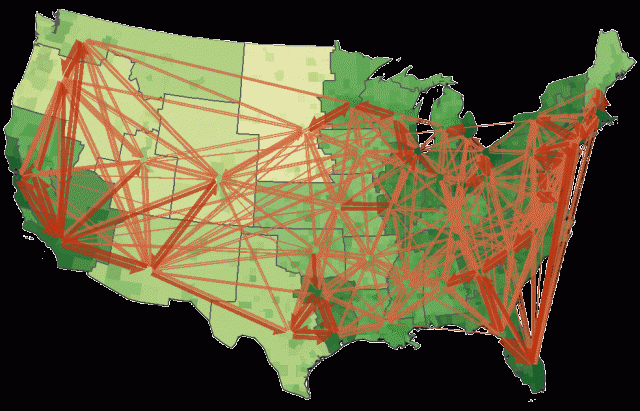spatial interaction
SPATIAL INTERACTION IS A dynamic flow process from one location to another. It is a general concept that may refer to the movement of human beings such as intraurban commuters or intercontinental migrants, but may also refer to traffic in goods such as raw materials or to flows of intangibles such as information.
While the origin of the term may be traced to French geographers of the early 20th century, Edward Ullman's Geography as Spatial Interaction is normally cited as the seminal statement of the concept. In Ullman's conception there were “three bases for spatial interaction” or more fundamentally, three reasons for why things move: complementarity, transferability, and intervening opportunity.
Complementarity refers to the presence of a demand or deficit at one location and a supply or surplus at another without which there is no economic rationale for any movement. A workplace such as a factory or office tower is an example of a place with a demand for labor, while a residential neighborhood provides a source of workers. A sawmill requires logs, while a forest provides them. To adapt a metaphor from physics, complementarity is like a potential gradient with goods and people flowing from a higher energy state, where they are in surplus, to a lower energy state, where they are in deficit. From the realm of PHYSICAL GEOGRAPHY, wind is the flow of air between complementary atmospheric zones: from a high-pressure cell to a low-pressure cell.

The complementary surplus-deficit relationship is commodity-specific, and if the deficit is precisely specified, the direction and distance of movement will depend on the location where there is a surplus of just that kind of good. Complementary relationships may be the impetus for interaction between distant regions, such as the flow of petroleum over thousands of miles from the MIDDLE EAST to Europe, and within regions, such as the flow of shoppers from residential neighborhoods to small convenience stores over a distance of less than a mile or two.
David Ricardo's classical economic concept of “comparative advantage” provides a relative measure of the degree of economic complementarity between two countries based on their opportunity costs. All other things being equal, one nation will export goods to another nation when it can produce a unit quantity at a lower relative cost than the importing nation. In a similar vein, John Dunning's eclectic theory of foreign direct investment predicts that foreign investment will take place when a firm in one country has such a powerful “firm-specific advantage” that it can overcome the barriers to entry in a foreign country market in which there is a “location-specific advantage” in factor costs such as land, labor, or capital. Thus, foreign direct investment flows from regions with a surplus of capital to regions with a capital deficit, creating the international ownership lineaments that make-up the multinational corporation.
Transferability refers to the cost of overcoming distance measured in real economic terms of either time or travel cost. The cost of overcoming distance is known as the “friction of distance.” If the friction of distance is too great, interaction will not occur in spite of a complementary supply-demand relationship. Friction of distance depends on prevailing transportation technology and the price of energy. In general, the friction of distance has decreased over time, which is the prime factor in globalization and the emergence of megacities. Daily commuter flows, for example, are always subject to a travel time constraint; a couple hours is a typical maximum for the one-way daily journey to work. High-value, low-weight goods such as jewelry are imminently transferable and exported on a global scale, while heavy, low-value goods such as concrete blocks are usually used very close to where they are produced.
Intervening opportunity is the third basis for interaction although it typically is considered as the reason for a lack of interaction between two complementary locations. Complementarity will only generate a flow if there is no intervening, or closer, location. The flow of goods that would otherwise occur between two complementary locations may be diverted to a third location if it represents an intervening opportunity: a closer complementary alternative with a cheaper overall cost of transportation.
However, Ullman noted that the trade-diverting effect of an intervening opportunity could eventually facilitate interaction between more distant complementary locations. In his example, the nearest (intervening) source of logs would justify construction of a short logging railway from the mill to the forest resource and when it was harvested, the railway would be extended to the next intervening opportunity and so on until it ultimately reached a more distant complementary location. Flows to the more distant complementary location might never have been established had the transportation infrastructure not been constructed in a series of incremental extensions to a series of intervening opportunities.
Important forms of spatial interaction such as traffic flows and migration may be predicted and explained based on an analogy with Newton's model of the gravitational attraction between celestial bodies. Assuming that there is no intervening opportunity, the degree of complementarity between any two regions is proportional to the product of the populations of the origin and destination regions.
The concept of spatial interaction can be traced to French geographers' notions of geographie de circulation, including both the movement of physical objects and the communication of intangible ideas. But its fullest development as the most fundamental of all geographic concepts came in the middle 1950s as the seminal contribution of Ullman.
Prior to Ullman, geography had been conceptualized as a way of describing the areal differentiation of sites. With the spatial interaction concept, Ullman shifted attention to situation as a second and equally important locational attribute. Areal differentiation emerged as the outcome of transportation and trade that permitted specialization in particular economic activities and concentrations of various social groups.